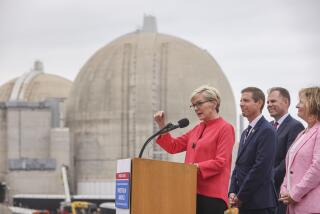U.S. to Aid New Rocket Fuel Plant
- Share via
WASHINGTON — The Pentagon and the National Aeronautics and Space Administration will subsidize the building of a new rocket fuel plant to replace the Pacific Engineering & Production Co. facility near Henderson, Nev., that blew up last month, Air Force officials said Tuesday.
The plant produced nearly half the nation’s supply of ammonium perchlorate, a key component of the solid fuel used to launch the space shuttle and to power many of the military’s nuclear missiles, including the MX and the submarine-launched Trident.
Shuttle Flights
Pentagon and NASA officials have been concerned that unless the lost ammonium perchlorate production capacity is restored quickly, construction and flight schedules for the shuttle and numerous military rockets will be delayed. NASA has enough fuel on hand for four or five shuttle flights, which will take the program into the middle of next year, officials said.
The Pacific Engineering facility was leveled by a powerful blast May 4 after a fire, believed fed by a broken underground gas line, started in a chemical mixing room. The blast killed two workers and injured more than 300 people. Damage was estimated at $74 million.
The subsidy will be in the form of a five- to seven-year contract to purchase the material at above-market prices, with the surcharge to be used to allow Pacific Engineering to recover the cost of rebuilding the plant, Lt. Col. Rick Oborn, an Air Force spokesman, said.
The government will also provide a similar arrangement to help Kerr-McGee Corp., the nation’s only other producer of the chemical, expand its ammonium perchlorate production capacity, the Air Force said. Kerr-McGee’s ammonium perchlorate plant is also near Henderson.
The cost of the subsidy program has not yet been determined, but one Pentagon official estimated that building two plants to provide an adequate supply of the chemical will be about $95 million.
Oborn said Pacific Engineering and Kerr-McGee are unlikely to build the new ammonium perchlorate plants in Henderson, a suburb of Las Vegas. Pacific Engineering officials had said earlier that they were looking at possible sites in Texas, Utah or more remote regions of Nevada. Kerr-McGee declined to comment about its plans.
A Year to Build
Oborn said it would take at least a year to build the new plants.
Ammonium perchlorate in rocket fuel acts as an oxidizer, providing oxygen to permit solid rocket fuel to burn outside the Earth’s atmosphere.
The rebuilding program was devised by Robert B. Costello, undersecretary of defense for acquisition, and Richard H. Truly, NASA’s space flight chief. The officials approved the plan late last week in Washington, but Pacific Engineering and Kerr-McGee spokesmen said the companies had not yet formally approved the deal.
“All I can say is that some of our officials have met with DOD (Department of Defense) and NASA and did have discussions relative to the ammonium perchlorate capability but no formal agreement has been reached and discussions are ongoing,” Kerr-McGee director of communications Paul Reed said Tuesday.
A Pacific Engineering spokeswoman said the company had no immediate comment. “There are too many uncertainties,” she said.
The federal plan would give the two producers assurances that the government would buy at least 20 million pounds of ammonium perchlorate a year from each plant. The Pacific Engineering plant produced about that much each year, while the Kerr-McGee facility makes about 32 million pounds of the material annually.
NASA and the Defense Department now need about 50 million pounds a year for rocket and missile programs, Oborn said. He said that shortages will be felt soon because of the loss of the Pacific Engineering plant and that NASA and the Defense Department are discussing which rocket programs will be scaled back until the new plants come on line.
More to Read
Sign up for Essential California
The most important California stories and recommendations in your inbox every morning.
You may occasionally receive promotional content from the Los Angeles Times.













